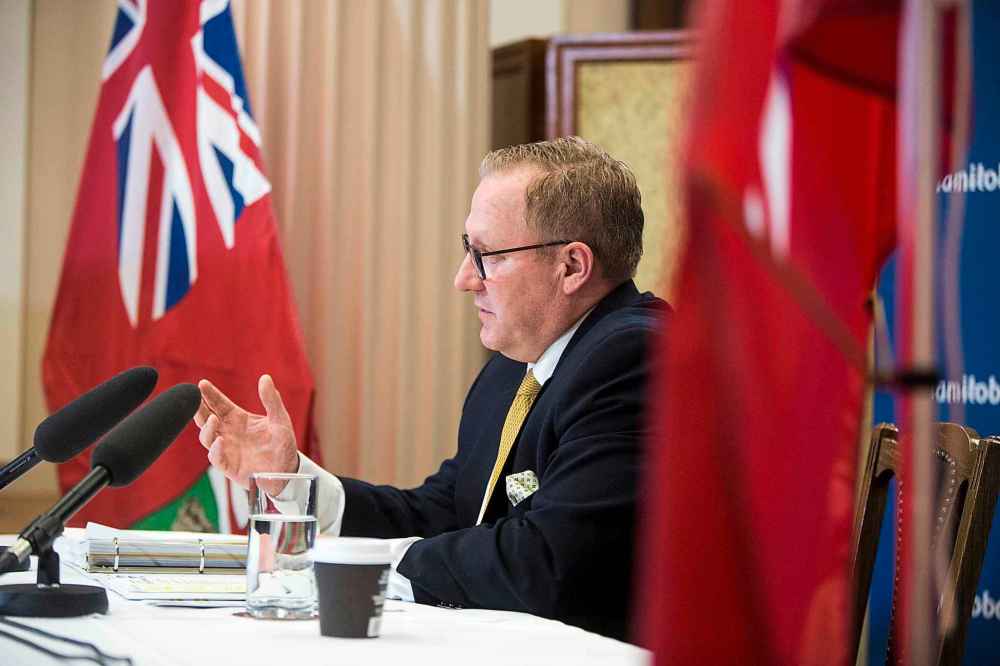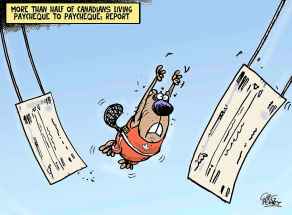Credit report card shows Pallister’s austerity measures paying off
Read this article for free:
or
Already have an account? Log in here »
To continue reading, please subscribe:
Monthly Digital Subscription
$0 for the first 4 weeks*
- Enjoy unlimited reading on winnipegfreepress.com
- Read the E-Edition, our digital replica newspaper
- Access News Break, our award-winning app
- Play interactive puzzles
*No charge for 4 weeks then price increases to the regular rate of $19.00 plus GST every four weeks. Offer available to new and qualified returning subscribers only. Cancel any time.
Monthly Digital Subscription
$4.75/week*
- Enjoy unlimited reading on winnipegfreepress.com
- Read the E-Edition, our digital replica newspaper
- Access News Break, our award-winning app
- Play interactive puzzles
*Billed as $19 plus GST every four weeks. Cancel any time.
To continue reading, please subscribe:
Add Free Press access to your Brandon Sun subscription for only an additional
$1 for the first 4 weeks*
*Your next subscription payment will increase by $1.00 and you will be charged $16.99 plus GST for four weeks. After four weeks, your payment will increase to $23.99 plus GST every four weeks.
Read unlimited articles for free today:
or
Already have an account? Log in here »
Hey there, time traveller!
This article was published 07/10/2019 (2259 days ago), so information in it may no longer be current.
Finance officials weren’t quite doing cartwheels last week when a major credit rating agency upgraded the provincial government’s fiscal status. But it’s the closest it gets these days for the folks who manage the province’s finances to pop the bubbly.
S&P Global Ratings revised Manitoba’s outlook from stable to positive, one of the first concrete signs the Pallister government’s spending controls and deficit-elimination efforts are paying off.
“The fiscal 2019 results show that the government’s efforts over the past three years to restructure its cost base in order to control expenditure growth have not been in vain,” S&P wrote in its report, released Friday.
The bond rating agency noted government is ahead of schedule by two years in eliminating the deficit and is expected to post modest surpluses by 2022-23. S&P did not revise the province’s long-term rating of A+. But the agency said if government meets its revenue targets over the next 12 to 24 months, there’s a one in three chance it could raise the rating “by one notch.”
“The fiscal 2019 results show that the government’s efforts over the past three years to restructure its cost base in order to control expenditure growth have not been in vain.” – S&P Global Ratings
After three credit rating downgrades from 2015 to 2017, that’s music to the ears of those in government who pore over the books every day, looking for savings and more efficient ways of spending tax dollars. It’s not glamorous work. The focus publicly is often around how spending controls are hurting front-line services (some of which is fact, a lot of which is fiction). So when finance officials get this kind of external validation, as modest as it may be, it is cause for celebration.
For taxpayers, improved credit ratings mean government can borrow money at a lower interest rate. The province is already spending $1 billion a year in debt-servicing charges, up from $850 million just a few years ago. That’s money that could be spent elsewhere, including on front-line services.

Manitoba’s debt is a problem. Even after the province eliminates its deficit, it still has a massive debt to contend with, one that will continue to grow even after the books are balanced. Government not only borrows to pay for daily expenditures when it’s in deficit, it also borrows to pay for capital costs, such as hospital expansions, highway upgrades and flood mitigation.
Which means the provincial government isn’t out of the woods yet when it comes to turning its finances around. S&P warned that Manitoba has the highest government debt per capita of any province in Canada. That’s due in part to significant debt taken on by Manitoba Hydro to finance construction of the new Bipole III transmission line and the Keeyask Generating Station.
Add to that the possibility of a global economic downturn, which could impact Manitoba’s revenues, and there’s a chance the province could lose its more favourable outlook, S&P said. Government can’t take its foot off the pedal just yet when it comes to cost controls.
Barring a serious economic downturn, the state of the province’s finances are looking up. Last week’s credit outlook update was a small victory, but it was a victory nonetheless.
For the most part, the S&P report paints a cautiously optimistic picture of Manitoba’s finances. While the province continues to be saddled with heavy debt, debt accumulation has slowed. Debt as a percentage of the size of the economy (the debt-to-GDP ratio), has levelled off at 35.6 per cent after growing every year from 2008 to 2016. The ratio stood at 21.6 per cent in 2008.
S&P also noted the province has plenty of cash on hand (which is why it was able recently to put $407 million into its so-called rainy-day fund) and that its liquidity is more than sufficient to meet its debt obligations.

The alternative to the cost-control measures we’ve seen over the past three years would have been to further increase the size of the deficit and debt. That would have resulted in more credit-rating downgrades, higher debt-servicing costs and less money for front-line services. It would have been a disaster.
Critics of government’s balanced-budget measures don’t like to talk about that side of the equation. It’s easier to complain about government “cuts” and “austerity” than it is to intelligently debate the alternative of perpetual deficit financing.
Barring a serious economic downturn, the state of the province’s finances are looking up. Last week’s credit outlook update was a small victory, but it was a victory nonetheless.

Tom has been covering Manitoba politics since the early 1990s and joined the Winnipeg Free Press news team in 2019.
Our newsroom depends on a growing audience of readers to power our journalism. If you are not a paid reader, please consider becoming a subscriber.
Our newsroom depends on its audience of readers to power our journalism. Thank you for your support.










